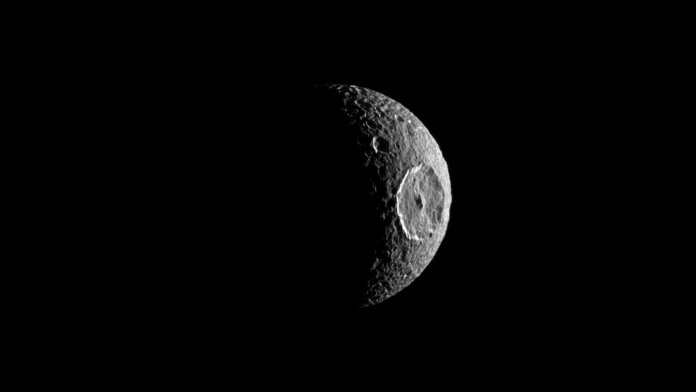Liquid water is a crucial prerequisite for life as we know it. When astronomers first looked out into the solar system, it seemed Earth was a special case in this respect. They found enormous balls of gas, desert worlds, blast furnaces, and airless hellscapes. But evidence is growing that liquid water isn’t rare at all—it’s just extremely well-hidden.
The list of worlds with subsurface oceans in our solar system is getting longer by the year. Of course, many people are familiar with the most obvious cases: The icy moons Enceladus and Europa are literally bursting at the seams with water. But other less obvious candidates have joined their ranks, including Callisto, Ganymede, Titan, and even, perhaps, Pluto.
Now, scientists argue in a paper in Nature that we may have reason to add yet another long-shot to the list: Saturn’s “Death Star” moon, Mimas. Nicknamed for the giant impact crater occupying around a third of its diameter, Mimas has been part of the conversation for years. But a lack of clear evidence on its surface made scientists skeptical it could be hiding an interior ocean.
The paper, which contains fresh analysis of observations made by the Cassini probe, says changes in the moon’s orbit over time are best explained by the presence of a global ocean deep below its icy crust. The team believes the data also suggests the ocean is very young, explaining why it has yet to make its presence known on the surface.
“The major finding here is the discovery of habitability conditions on a solar system object which we would never, never expect to have liquid water,” Valery Lainey, first author and scientist at the Observatoire de Paris, told Space.com. “It’s really astonishing.”
The Solar System Is Sopping
How exactly do frozen moons on the outskirts of the solar system come to contain whole oceans of liquid water?
In short: Combine heat and a good amount of ice and you get oceans. We know there is an abundance of ice in the outer solar system, from moons to comets. But heat? Not so much. The further out you go, the more the sun fades into the starry background.
Interior ocean worlds depend on another source of heat—gravity. As they orbit Jupiter or Saturn, enormous gravitational shifts flex and warp their insides. The friction from this grinding, called tidal flexing, produces heat which melts ice to form salty oceans.
And the more we look, the more we find evidence of hidden oceans throughout the outer solar system. Some are thought to have more liquid water than Earth, and where there’s liquid water, there just might be life—at least, that’s what we want to find out.
Yet Another Ocean World?
Speculation that Mimas might be an ocean world isn’t new. A decade ago, small shifts in the moon’s orbit measured by Cassini suggested it either had a strangely pancake-shaped core or an interior ocean. Scientists thought the latter was a long shot because—unlike the cracked but largely crater-free surfaces of Enceladus and Europa—Mimas’s surface is pocked with craters, suggesting it has been largely undisturbed for eons.
The new study aimed for a more precise look at the data to better weigh the possibilities. According to modeling using more accurate calculations, the team found a pancake-shaped core is likely impossible. To fit observations, its ends would have to extend beyond the surface: “This is incompatible with observations,” they wrote.
So they looked to the interior ocean hypothesis and modeled a range of possibilities. The models not only fit Mimas’s orbit well, they also suggest the ocean likely begins 20 to 30 kilometers below the surface. The team believes the ocean would likely be relatively young, somewhere between a few million years old and 25 million years old. The combination of depth and youth could explain why the moon’s surface remains largely undisturbed.
But what accounts for this youth? The team suggests relatively recent gravitational encounters—perhaps with other moons or during the formation of Saturn’s ring system, which some scientists believe to be relatively young also—may have changed the degree of tidal flexing inside Mimas. The associated heat only recently became great enough to melt ice into oceans.
Take Two
It’s a compelling case, but still unproven. Next steps would involve more measurements taken by a future mission. If these measurements match predictions made in the paper, scientists might confirm the ocean’s existence as well as its depth below the surface.
Studying a young, still-evolving interior ocean could give us clues about how older, more stable oceans formed in eons past. And the more liquid water we find in our own solar system, the more likely it’s common through the galaxy. If water worlds—either in the form of planets or moons—are a dime a dozen, what does that say about life?
This is, of course, still one of the biggest questions in science. But each year, thanks to clues gathered in our solar system and beyond, we’re stepping closer to an answer.
Image Credit: NASA/JPL/Space Science Institute



